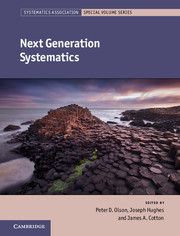Book contents
- Frontmatter
- Contents
- List of contributors
- Introduction: studying diversity in an era of ubiquitous genomics
- Part I Next Generation Phylogenetics
- Part II Next Generation Biodiversity Science
- 6 Perspective: Après le déluge: ubiquitous field barcoding should drive 21st century taxonomy
- 7 Perspective: Biodiversity and the (data) beast
- 8 Next generation biodiversity analysis
- 9 Protist systematics, ecology and next generation sequencing
- Part III Next Generation Challenges and Questions
- Index
- Systematics Association Special Volumes
- Plate section
- References
8 - Next generation biodiversity analysis
from Part II - Next Generation Biodiversity Science
Published online by Cambridge University Press: 05 June 2016
- Frontmatter
- Contents
- List of contributors
- Introduction: studying diversity in an era of ubiquitous genomics
- Part I Next Generation Phylogenetics
- Part II Next Generation Biodiversity Science
- 6 Perspective: Après le déluge: ubiquitous field barcoding should drive 21st century taxonomy
- 7 Perspective: Biodiversity and the (data) beast
- 8 Next generation biodiversity analysis
- 9 Protist systematics, ecology and next generation sequencing
- Part III Next Generation Challenges and Questions
- Index
- Systematics Association Special Volumes
- Plate section
- References
Summary
Introduction – facing challenges
Biodiversity, in the words of E. O. Wilson, is ‘in one sense, everything’ (Wilson, 1997). This is the most catholic of the numerous definitions that various authors have given of ‘biological diversity’ or ‘biodiversity’. To give some idea of the most common constituents of these definitions, Figure 8.1 shows a word cloud based on 22 definitions, with the size of the word being proportional to its frequency in the definitions included. Clearly, species and ecosystems play a central role in what we call ‘biodiversity’. However, our inability to measure and document – even to define – biodiversity's basic units (i.e. species) has resulted in orders of magnitude difference in our best estimates of Earth's biotic diversity (May 1992; 2011; Mora et al. 2011; Pimm et al. 2014).
Biodiversity and related studies have often focused on a narrow spectrum of species of mainly charismatic groups (Clark and May 2002; Pawar 2003; Chariton et al. 2010a). This is understandable, though not excusable, given the challenges inherent in studies including a greater variety of species and vast ecosystems. In an ambitious, taxonomically diverse (but not comprehensive) inventory of a tropical forest in Cameroon, Lawton and colleagues (1998) found that the effort required for identification ranged from 50 ‘scientist-hours’ required to assign all morphospecies to known species for birds, to 6000 ‘scientist-hours’ to assign 10% of individual nematodes to species (over 90% of morphospecies could not be assigned to known species). In another study, the sampling and identification time required for 15 different taxa at five tropical sites was 18 200 person-hours (Barlow et al. 2007; Gardner et al. 2008). In fact, projects that aim at large-scale documentation of biodiversity, or bioinventories, have been faced with a serious bottleneck in the timely identification of specimens. Dan Janzen and Winnie Hallwachs, who run one of the largest and longest bioinventory efforts located in the Área de Conservación Guanacaste (ACG), Northwest Costa Rica, have been using molecular tools such as DNA barcoding (see below) to address this bottleneck (Janzen et al. 2009). Additionally, the need for more efficient approaches for biodiversity analysis is reflected in many situations where timely and accurate characterization of biota is critical (see below).
- Type
- Chapter
- Information
- Next Generation Systematics , pp. 175 - 194Publisher: Cambridge University PressPrint publication year: 2016

